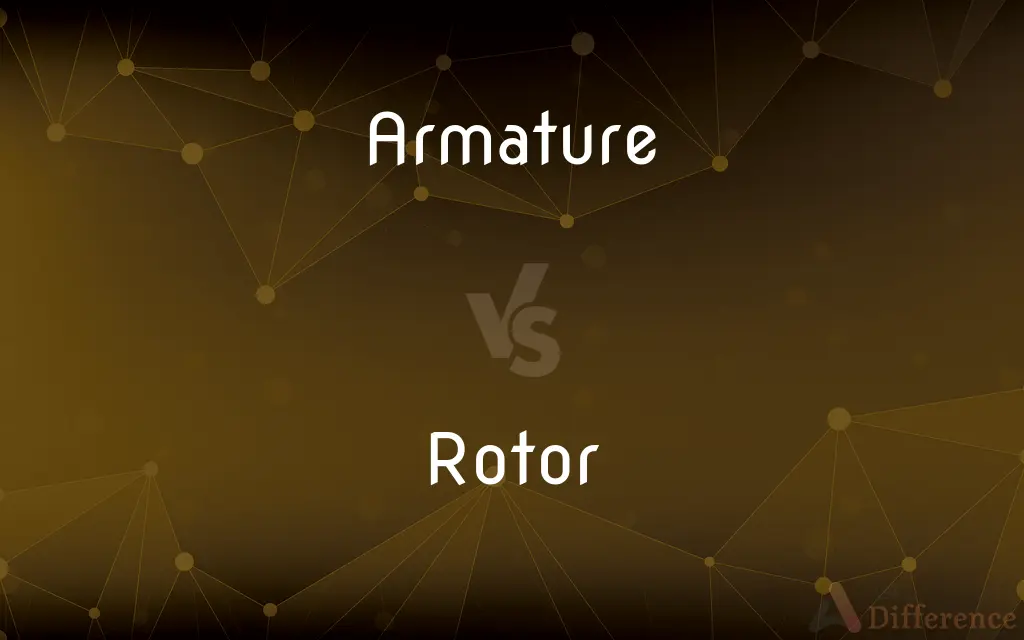Armature vs. Rotor — What's the Difference?
By Maham Liaqat & Fiza Rafique — Updated on March 27, 2024
Armature refers to the component of an electric machine that carries alternating current (AC) or direct current (DC), whereas a rotor is the rotating part of an electrical machine, such as a motor or generator.

Difference Between Armature and Rotor
Table of Contents
ADVERTISEMENT
Key Differences
The armature is a critical component in electrical machinery, designed to carry current and interact with the magnetic field to produce electromotive force (EMF). While the rotor, a subset of armature in certain contexts, specifically denotes the rotating part of the machine, responsible for converting electrical energy to mechanical energy or vice versa.
Armatures can exist in both AC and DC machines and are usually found within the rotating part of the machine, except in stationary armatures of AC machines like synchronous generators. On the other hand, rotors are always the moving components, designed to rotate within the stator's magnetic field, providing the mechanical output or inducing an electric current.
In the context of DC machines, the armature typically rotates within a fixed magnetic field, and its construction is designed to enhance the efficiency of current carrying and conversion. Whereas, in AC machines, the rotor can either be a wound rotor, carrying windings connected to the external circuit, or a squirrel-cage rotor, which operates based on induced current.
The function of an armature is directly related to its design and placement within the electrical machine, affecting how effectively it interacts with the magnetic field to generate motion or EMF. Conversely, the rotor's design, particularly in terms of the winding and materials used, is crucial for determining the efficiency, torque, and speed of the electrical machine.
In maintenance and engineering, understanding the distinction between an armature and a rotor is essential, as each has specific roles, wear characteristics, and impact on the machine's overall performance. For instance, armature maintenance might focus on the integrity of the windings and commutators, while rotor maintenance could concentrate on bearings and balance.
ADVERTISEMENT
Comparison Chart
Definition
The component that carries AC or DC, interacting with the magnetic field.
The rotating part of an electrical machine.
Function
To produce electromotive force (EMF) through interaction with a magnetic field.
To convert electrical energy to mechanical energy or vice versa.
Placement
Can be rotating or stationary, depending on the machine type.
Always the moving part within an electrical machine.
Types
In DC machines, consists of windings on a rotating shaft. In AC machines, can be stationary.
Can be wound (with external connections) or squirrel-cage (induced current).
Maintenance Focus
Integrity of windings, commutators, and brushes.
Bearings, balance, and the condition of windings in wound rotors.
Compare with Definitions
Armature
Design for efficiency.
Armatures are designed with windings to efficiently conduct electricity and generate force.
Rotor
Types of rotors.
AC motors can have squirrel-cage rotors, which operate without direct electrical connections.
Armature
Carries current.
The armature in a DC motor carries direct current, interacting with the magnetic field to produce motion.
Rotor
Rotating component.
The rotor is the moving part of an electric motor, turning electrical energy into mechanical energy.
Armature
Maintenance of windings.
Maintaining an armature involves checking the integrity of its windings and commutators.
Rotor
Always in motion.
Regardless of the machine type, the rotor is designed to move, contrasting with some stationary armatures.
Armature
Found in AC and DC machines.
The concept of an armature applies to both alternating and direct current machines, highlighting its versatility.
Rotor
Efficiency and torque.
The design of a rotor influences the motor's efficiency, torque, and operating speed.
Armature
Varied placement.
In a synchronous generator, the armature is stationary, contrasting with the rotating armature of a DC motor.
Rotor
Focus on bearings and balance.
Rotor maintenance typically focuses on ensuring proper balance and bearing integrity for smooth operation.
Armature
The rotating part of a dynamo, consisting essentially of copper wire wound around an iron core.
Rotor
A rotating part of an electrical or mechanical device.
Armature
The part of an electromagnetic, optical, or other device that moves to establish a point of contact, especially to read or write data, as on a hard drive.
Rotor
An assembly of rotating horizontal airfoils, as that of a helicopter.
Armature
A piece of soft iron connecting the poles of a magnet.
Rotor
A rotating part of a mechanical device; for example, in an electric motor, generator, alternator, or pump.
Armature
(Biology) A protective covering, structure, or organ of an animal or a plant, such as teeth, claws, thorns, or the shell of a turtle.
Rotor
(aviation) The wing of a helicopter or other rotary-wing aircraft.
Armature
A framework serving as a supporting core for the material used to make a sculpture.
Rotor
(meteorology) A type of powerful horizontal-axis atmospheric vortex generated by the interaction of strong winds with mountainous terrain.
Armature
The rotating part of an electric motor or dynamo, which mostly consists of coils of wire around a metal core.
Rotor
A quantity having magnitude, direction, and position.
Armature
The moving part in an electromechanical device like a loudspeaker or a buzzer.
Rotor
The rotating part of a generator or motor. Contrasted with stator, the stationary part.
Armature
A piece of soft steel or iron that connects the poles of a magnet, to preserve its strength by forming a circuit.
Rotor
The rotating armature of a motor or generator
Armature
(sculpture) A supporting framework in a sculpture.
Rotor
The revolving bar of a distributor
Armature
(computer graphics) A kinematic chain (a system of bones or rigid bodies connected by joints) that is used to pose and deform models, often character models.
Rotor
Rotating mechanism consisting of an assembly of rotating airfoils; horizontal rotors on a helicopter or compressor rotors of a jet engine
Armature
A protective organ, structure, or covering of an animal or plant, for defense or offense, like claws, teeth, thorns, or the shell of a turtle.
Armature
Armor, or a suit of armor.
Armature
Any apparatus for defence.
Armature
The frame of a pair of glasses.
Armature
To provide with an armature (any sense).
Armature
Armor; whatever is worn or used for the protection and defense of the body, esp. the protective outfit of some animals and plants.
Armature
A piece of soft iron used to connect the two poles of a magnet, or electro-magnet, in order to complete the circuit, or to receive and apply the magnetic force. In the ordinary horseshoe magnet, it serves to prevent the dissipation of the magnetic force.
Armature
Iron bars or framing employed for the consolidation of a building, as in sustaining slender columns, holding up canopies, etc.
Armature
That moving part of a dynamo or electric generator in which a current is induced by a moving through a magnetic field, or, in an electric motor, the part through which the applied current moves, thereby generating torque. The armature usually consists of a series of coils or groups of insulated conductors surrounding a core of iron.
Armature
Coil in which voltage is induced by motion through a magnetic field
Common Curiosities
What defines a rotor?
A rotor is the rotating part of an electrical machine, which can either convert electrical energy to mechanical motion or generate electricity.
What types of rotors are there in AC motors?
AC motors may have wound rotors or squirrel-cage rotors, each with distinct operational and maintenance characteristics.
How do you maintain an armature?
Maintenance involves checking the windings, commutators, and brushes for integrity and functionality.
What is an armature?
An armature is a component in electric machines that carries alternating or direct current to interact with a magnetic field, producing motion or electromotive force.
Can the armature be stationary?
Yes, in AC machines like synchronous generators, the armature can be stationary, with the magnetic field rotating around it.
What is the significance of rotor design?
The design of the rotor affects the efficiency, speed, and torque of the machine, impacting its overall performance and application.
Are the terms 'armature' and 'rotor' interchangeable?
While they can be related, they are not always interchangeable; the term 'armature' focuses on the component carrying current, whereas 'rotor' specifically refers to the rotating part of a machine.
What role does the rotor play in generators?
In generators, the rotor induces an electrical current in the armature by rotating within a magnetic field, generating electricity.
What is a squirrel-cage rotor?
A squirrel-cage rotor is a type of rotor in AC motors where current is induced in the rotor bars by the rotating magnetic field, without direct electrical connections.
What maintenance does a rotor require?
Rotor maintenance focuses on ensuring the bearings are in good condition and the rotor is properly balanced.
Why is the armature important in electrical machines?
The armature interacts with the magnetic field to produce the essential motion or electromotive force in electrical machines.
What happens if the armature or rotor fails?
Failure can lead to a loss of efficiency, malfunction, or complete stoppage of the machine, highlighting the importance of regular maintenance.
How does an armature differ from a rotor?
While all rotors can be considered part of an armature in certain machines, not all armatures are rotors; armatures can be stationary or rotating, and are defined by their role in carrying current.
How does the armature generate electromotive force?
It generates electromotive force through the interaction of its current-carrying conductors with the machine's magnetic field.
How does the design of the armature affect a machine's performance?
The design influences how efficiently the armature can carry current and interact with the magnetic field, affecting the machine's output, efficiency, and operational characteristics.
Share Your Discovery

Previous Comparison
Million vs. Crore
Next Comparison
Fedora vs. DebianAuthor Spotlight
Written by
Maham LiaqatCo-written by
Fiza RafiqueFiza Rafique is a skilled content writer at AskDifference.com, where she meticulously refines and enhances written pieces. Drawing from her vast editorial expertise, Fiza ensures clarity, accuracy, and precision in every article. Passionate about language, she continually seeks to elevate the quality of content for readers worldwide.
















































